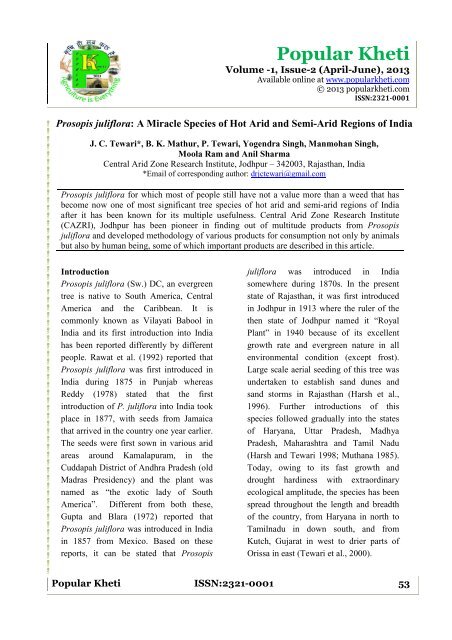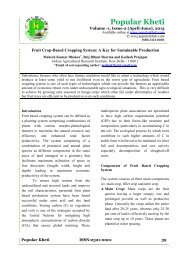Prosopis juliflora: A Miracle Species of Hot Arid and ... - Popular Kheti
Prosopis juliflora: A Miracle Species of Hot Arid and ... - Popular Kheti
Prosopis juliflora: A Miracle Species of Hot Arid and ... - Popular Kheti
You also want an ePaper? Increase the reach of your titles
YUMPU automatically turns print PDFs into web optimized ePapers that Google loves.
Tewari et al., 2013, Pop. <strong>Kheti</strong>, 1(2): 53-59up to pressure 160 kg/cm 2 to make it as ablock. The volume reduction was foundmore than 80 percent, which is veryhelpful for storage <strong>and</strong> transportation; <strong>and</strong>as well as enhancing the shelf life.Products for Human Consumption<strong>Prosopis</strong> c<strong>of</strong>fee: P. <strong>juliflora</strong> c<strong>of</strong>fee ismajor one amongsome <strong>of</strong> humanconsumption productsdeveloped from P.<strong>juliflora</strong>. The c<strong>of</strong>feehas given br<strong>and</strong> nameas ‘Juli C<strong>of</strong>fee’. Thetechnology <strong>of</strong> P.<strong>juliflora</strong> c<strong>of</strong>fee preparation has beenst<strong>and</strong>ardized <strong>and</strong> passed to partnerindustry <strong>of</strong> the project. However, toxicityanalysis for human consumption <strong>of</strong> P.<strong>juliflora</strong> pod flour is in progress at NIN,Hyderabad. Once a clean chit is obtainedin this context, P. <strong>juliflora</strong> c<strong>of</strong>fee will alsobe launched in the market. The c<strong>of</strong>fee wasprepared by roasting P. <strong>juliflora</strong> pod flourat different temperatures <strong>and</strong> mixingchicory (Cichorium intybus) with rawc<strong>of</strong>fee powder. The prepared c<strong>of</strong>feecontained 70% P. <strong>juliflora</strong> pod powder<strong>and</strong> 30% chicory mixture (containing 20%raw c<strong>of</strong>fee powder + 10% chicorypowder).<strong>Prosopis</strong> <strong>juliflora</strong> syrup: Ripe <strong>and</strong> soundpods were selected, washed <strong>and</strong> brokeninto small pieces. One liter <strong>of</strong> water isadded to 350 g <strong>of</strong> pods, <strong>and</strong> then boiledfor two hours. The product is then sifted toseparate the coarse particles. One hundredgram liquid was obtained from 350g pods.To obtain the syrup, the liquid is boileduntil it reaches thenecessaryconsistency. Thisthick liquid wasyellowish brownin colour <strong>and</strong> canbe used as abeverage. It can also be mixed with milk<strong>and</strong> fruit juices. This syrup is widely usedin Latin <strong>and</strong> South America countries. Theresidue left after preparing the syrup wasused for processing fine flour <strong>and</strong> finefiber. The quantum <strong>of</strong> fine flour <strong>and</strong> fiberobtained from used 350g pods was 62 g<strong>and</strong> 26 g, respectively. The flour obtainedby this process was quite fine, which washighly suitable for use in confectionaryitems. The process technologyst<strong>and</strong>ardized for these products is givenbelow:A. Concentrated carbohydrate extract with characteristicssimilar to those <strong>of</strong> molasses, but with a bitter taste.B. Pulpy mesocarp with better taste; it can be concentrated, <strong>and</strong>is being studied for jelly production.C. Contains peelings, coriaceous endocarp <strong>and</strong> seeds.D. Residue remaining after sifting; it contains 11% protein <strong>and</strong>can be used for animal feed.Fig. Schematic representation <strong>of</strong> processtechnology to prepare Juli Syrup, Fine PodFlour <strong>and</strong> Fine Pod Fiber<strong>Popular</strong> <strong>Kheti</strong> ISSN:2321-0001 55
Tewari et al., 2013, Pop. <strong>Kheti</strong>, 1(2): 53-59All these above mentioned products are fewexamples <strong>of</strong> <strong>Prosopis</strong> pod utility. There canbe numerous uses <strong>of</strong> its pods <strong>and</strong> other plantparts. The general uses <strong>of</strong> P. <strong>juliflora</strong> arementioned as follows:1. Used as fuel: Although the initialplantations in India were mainlyestablished for the purpose <strong>of</strong>conservation, <strong>Prosopis</strong> <strong>juliflora</strong> hasbecome the main source <strong>of</strong> fuel in ruralareas <strong>and</strong> to a large extent, in urban <strong>and</strong>semi-urban areas also. Today it fulfilsmore than 70 percent <strong>of</strong> the firewoodrequirements <strong>of</strong> the rural people in thetropical arid <strong>and</strong> semi-arid regions <strong>of</strong>India (Harsh <strong>and</strong> Tewari 1998).2. Use <strong>of</strong> <strong>Prosopis</strong> <strong>juliflora</strong> wood: Largerbranches <strong>and</strong> trunks yield a highquality timber, comparable in colour,finish <strong>and</strong> physical attributes to Indianrosewood <strong>and</strong> other commercialhardwoods. Its exceptional property isits negligible shrinkage (4.17%) whichis much less than for oak, maple orwalnut trees (14-16%). Because <strong>of</strong> thisquality furniture items made from<strong>Prosopis</strong> wood develop little or nocracking or warping later on (Singh,2008). In India use <strong>of</strong> <strong>Prosopis</strong> woodin furniture industries is very limitedbecause <strong>of</strong> non-availability <strong>of</strong> straightbole trees <strong>and</strong> also some extentbecause <strong>of</strong> a lack <strong>of</strong> knowledge. Inother countries, <strong>Prosopis</strong> species arewidely used for making furniturebecause <strong>of</strong> their high quality wood.The wood <strong>of</strong> P. <strong>juliflora</strong> is soluble tovarying degrees in water, sodiumhydroxide, alcohol <strong>and</strong> benzene, whichmeans that it can be successfullypulped for the production <strong>of</strong> writing<strong>and</strong> printing papers, textile fibres, tyrecord or cellophane. Tests haveindicated that writing <strong>and</strong> printingpapers could be produced from <strong>Prosopis</strong><strong>juliflora</strong> logs having 30 to 50 cm in girthwith 50 per cent cellulose <strong>and</strong> 30 percent lignin (Madan <strong>and</strong> T<strong>and</strong>on, 1991).3. Use <strong>of</strong> <strong>Prosopis</strong> <strong>juliflora</strong> biomass:<strong>Prosopis</strong> <strong>juliflora</strong> is the most efficientspecies to convert energy intobiomass. It is an excellent c<strong>and</strong>idatefor short rotation energy plantationsconsidering its fast growing nature,higher biomass production potential,drought <strong>and</strong> heat tolerance <strong>and</strong>excellent coppicing ability. Itproduces biomass about 25 to 30tons/ha/year at the short rotation age<strong>of</strong> 4 to 5 years (Patel, 1986). It wasreported that total biomass from<strong>Prosopis</strong> <strong>juliflora</strong> ranked first amongstthe high biomass producing nativetrees <strong>of</strong> arid <strong>and</strong> semi arid regions <strong>of</strong>India. (Singh, 2008). <strong>Prosopis</strong> <strong>juliflora</strong>trees maintain their greenery <strong>and</strong>continue to grow even during severest<strong>of</strong> the severe droughts in desert stateslike Rajasthan. It will be worthwhile tomention here that during 2002 droughtin India, it were the <strong>Prosopis</strong> trees whichprovided livelihood security to therural population, settled in arid <strong>and</strong>semi arid drought prone regions <strong>of</strong> thecountry. Wherever thickets <strong>of</strong> <strong>Prosopis</strong><strong>juliflora</strong> are creating danger <strong>of</strong>encroachments to agricultural fields,they can be harvested to generate<strong>Popular</strong> <strong>Kheti</strong> ISSN:2321-0001 56
Tewari et al., 2013, Pop. <strong>Kheti</strong>, 1(2): 53-59electricity. Kutch region <strong>of</strong> Gujarat hasample scope for electricity generationas <strong>Prosopis</strong> thickets are naturallygrowing in this tract.4. Use <strong>of</strong> <strong>Prosopis</strong> <strong>juliflora</strong> Gum: <strong>Prosopis</strong><strong>juliflora</strong> exudes gum from the sap wood.On average, about 40 g <strong>of</strong> gum isproduced from one plant. However, underdrought conditions more gum is exuded.A single person has been estimated to beable to collect 1-2 kg <strong>of</strong> P. <strong>juliflora</strong>gum/day in India (Tewari, 1998). Thetrade in exudate gum has been increasingin India, with P. <strong>juliflora</strong> gum estimatedto make up approximately 80% <strong>of</strong> thattotal gum production in Gujarat (Tewari,1998). P. <strong>juliflora</strong> gum exudationincreased at higher temperatures <strong>and</strong>ceased completely at the beginning <strong>of</strong> therainy season (Tewari, 1998). The gumforms adhesive mucilage, with favourablephysical <strong>and</strong> chemical properties, that canbe used as an emulsifying agent. <strong>Prosopis</strong>gum also finds use in confectionery,mending pottery, <strong>and</strong> as an adulterant <strong>and</strong>substitute for gum arabic. (Krochmal etal., 1954). It possesses fairly goodadhesive strength <strong>and</strong> can be used aspaper adhesive for brown paper <strong>and</strong> wallpaper (Vimal <strong>and</strong> Tyagi, 1986).5. Medicinal value <strong>of</strong> <strong>Prosopis</strong>: In India,boiling wood chips, a bark extract isused as an antiseptic on wounds, <strong>and</strong>gum is used to treat eye infections(Vimal <strong>and</strong> Tyagi, 1986). Researchdone at Central <strong>Arid</strong> Zone ResearchInstitute, Jodhpur (Azam et al., 2011)resulted in identification <strong>of</strong> antioxidantcompound which is present inconcentrated form (6-8%) in the heartwood <strong>of</strong> P. <strong>juliflora</strong>. The compound wasidentified as (-)-mesquitol (C 15 H 14 O 6 )which was compared with existingpharmacologically / therapeuticallyaccepted antioxidant probucol <strong>and</strong> α-tocopherol <strong>and</strong> found that (-)-mesquitol isbetter than probucol <strong>and</strong> α-tocopheroldrugs. <strong>Prosopis</strong> wood is reported to havemedicinal value for treatment <strong>of</strong>rheumatism <strong>and</strong> against miscarriage.Some <strong>of</strong> the alkaloids <strong>of</strong> <strong>Prosopis</strong>species are reported to be antifungal<strong>and</strong> antibacterial. In Brazil, P. <strong>juliflora</strong>flour is used as an aphrodisiac, syrupas an expectorant <strong>and</strong> tea infusionagainst digestive disturbances <strong>and</strong> skinlesions (Rocha, 1990).6. Role <strong>of</strong> <strong>Prosopis</strong> in Carbonsequestration: Wide spread <strong>of</strong> <strong>Prosopis</strong>trees may account for a significantamount <strong>of</strong> sequestered carbon, thoughtree species in arid <strong>and</strong> semi-arid zonesare not considered at present forcalculating carbon balances. But aconsiderable quantity <strong>of</strong> carbon can bestored in woody biomass <strong>of</strong> the species.Even a single rotation <strong>of</strong> P. <strong>juliflora</strong>would lead to significant amounts <strong>of</strong> totalcarbon sequestered. <strong>Arid</strong> zones presentlycontain the lowest levels <strong>of</strong> carbon in theworld on a per hectare basis, <strong>and</strong> it isnecessary to consider the role <strong>of</strong> arid zoneforests in carbon sequestration on aregional <strong>and</strong> global level.7. Soil Reclamation by <strong>Prosopis</strong> <strong>juliflora</strong>:<strong>Prosopis</strong> litter falling on the groundadds to the humus content <strong>of</strong> the saltaffected soils. The organic acids<strong>Popular</strong> <strong>Kheti</strong> ISSN:2321-0001 57
Tewari et al., 2013, Pop. <strong>Kheti</strong>, 1(2): 53-59produced from the decomposed litterreact with native calcium carbonate<strong>and</strong> release calcium, which exchangeswith sodium on the exchangecomplex. Being highly tolerant to soilsodicity, the <strong>Prosopis</strong> roots open upotherwise impermeable sodic soil <strong>and</strong>thus facilitate entry <strong>of</strong> water in thedeeper layers. The carbon dioxidereleased by its roots during respirationinteracts with water <strong>and</strong> producesweak acids like carbonic acid. Suchacid facilitate dissolution <strong>of</strong>precipitated calcium carbonate alreadypresent in sodic soils. Thus, help inreclamation <strong>of</strong> the sodic soil. Itreclaims the soil to such an extent thatagricultural crops can be grown withoutamendments (Singh, 2008).8. <strong>Prosopis</strong> <strong>juliflora</strong> combatingdesertification: Desertification is aninternational problem <strong>and</strong> P. <strong>juliflora</strong> issolution to this. No single species shouldever be seen as the sole answer but ratheras a tool in the continuing fight againstdesertification, l<strong>and</strong> degradation <strong>and</strong>resource depletion. Shelterbelts <strong>of</strong> P.<strong>juliflora</strong> <strong>and</strong> P. pallida are planted aroundfields in many semi-arid regions to reducewind speed. This reduces wind-inducedsoil erosion, decreases desiccation byreducing transpiration <strong>and</strong> consequentlyincreases plant <strong>and</strong> animal production.Shelterbelts can comprise one or morerows <strong>of</strong> trees, commonly three but up toten. In India, shelterbelts <strong>of</strong> P. <strong>juliflora</strong>were found to have a positive effect inreducing soil erosion compared with otherspecies <strong>and</strong> control plots. Gupta et al.(1983) noted a 36% reduction in themagnitude <strong>of</strong> wind erosion behind P.<strong>juliflora</strong> shelterbelts. Shankarnarayan <strong>and</strong>Kumar (1986) noted a decrease in areawind speeds <strong>of</strong> 33-38%, 17-26% <strong>and</strong> 12-21% at distances <strong>of</strong> 2, 5 <strong>and</strong> 10 times theheight <strong>of</strong> the trees, with consequentreduction in the quantities <strong>of</strong> soilremoved by erosive forces. In Sudan,wind speed was reduced by an average <strong>of</strong>14% inside P. <strong>juliflora</strong> plantations, <strong>and</strong>with reductions up to 36% at high windspeeds (El Fadl, 1997). Seed disposal <strong>of</strong>this species on vast areas has helpednatural regeneration <strong>and</strong> producedsignificant results in creating green belts<strong>and</strong> windbreaks to check the rapidlyspreading problem <strong>of</strong> desertification.ConclusionNo species in the nature is useless; we needto just find out their utilities. The countlessuses <strong>of</strong> P. <strong>juliflora</strong> have put it in thecategory <strong>of</strong> species <strong>of</strong> economic importance.Gone are the days when <strong>Prosopis</strong> <strong>juliflora</strong>was called for nothing more than a uselessweed. Due to its multiple uses, it has gainedpublic acceptance as a plant <strong>of</strong> recognizedeconomic value. Today it is the tree speciesutilized for its each <strong>and</strong> every part in variousways on a commercial basis. However, weneed to spread its usefulness far <strong>and</strong> wide sothat it can be recognized by everyone. Theinherent capacity to withst<strong>and</strong> in anyenvironmental conditions (except frost) <strong>and</strong>huge productivity potentiality <strong>of</strong> <strong>Prosopis</strong>can be converted into an even greater assetbesides generating tremendous localemployment opportunities <strong>and</strong> numerousbenefits through application <strong>of</strong> scientific <strong>and</strong>technical methods.<strong>Popular</strong> <strong>Kheti</strong> ISSN:2321-0001 58



